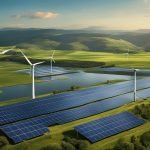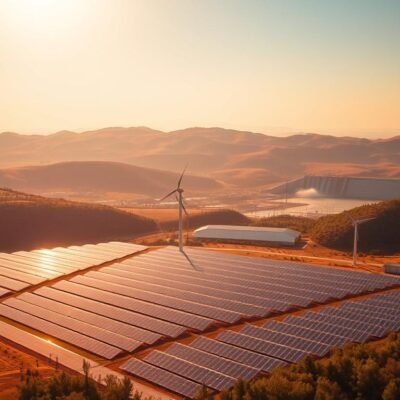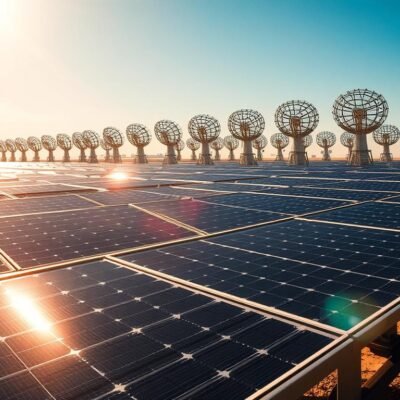We are living in a time of climate change and growing energy needs. Renewable energy solutions are key to a sustainable future. By using clean technology, we can make power from the sun, wind, and water. This is vital for a greener world and less reliance on fossil fuels.
This article highlights why we must adopt green energy. It shows how it helps the environment, economy, and society. Let’s explore how renewable energy can change our lives.
Key Takeaways
- Renewable energy solutions are essential for mitigating climate change.
- Shifting to green energy enhances energy security and reduces fossil fuel dependency.
- Investing in clean technology boosts local economies and job creation.
- Diverse sources such as solar, wind, and hydro are crucial for a sustainable energy future.
- The transition to renewable energy presents both challenges and opportunities.
- Innovative trends in energy efficiency pave the way for further advancements in the sector.
The Urgency of Renewable Energy
Switching to renewable energy is key to solving today’s big problems. It helps protect the environment and makes energy safer. Using fossil fuels too much harms the planet and causes global warming.
Environmental Sustainability: Climate Change Mitigation
Stopping climate change is crucial for our planet’s future. Fossil fuels are the main cause of greenhouse gases, making up over 75% of emissions. Using renewable energy like solar, wind, and hydroelectric can cut down on emissions and fight climate change. This change can make our environment cleaner and protect many species.
Energy Security: Reducing Dependency on Fossil Fuels
Having stable energy is important for countries around the world. Using less fossil fuel means more stable energy prices and less conflict over resources. This move helps countries be more independent and can create new jobs in renewable energy, boosting local economies.
| Aspect | Fossil Fuels | Renewable Energy |
|---|---|---|
| Emissions | High (75% of GHG emissions) | Low (near zero during operation) |
| Health Impact | Significant (air pollution) | Minimal (clean air) |
| Energy Prices | Volatile (affected by market) | Stable (local sources reduce volatility) |
| Economic Impact | Job losses in traditional sectors | Job creation in green technologies |
Renewable Energy Solutions for Sustainable Development
New renewable energy tech is key for sustainable development. It gives us affordable energy. As we use more energy, moving to cleaner sources helps the planet and our wallets. This way, we work towards a sustainable future and help communities grow strong.
Affordable and Accessible Energy Technology
Renewable energy tech has made energy cheaper and easier to get. Solar and wind power are now often the cheapest ways to make electricity. With more money going into these areas, more people and businesses can get energy without spending a lot. This means more energy for everyone and helps communities improve their lives.
Impact on Local Economies and Job Creation
Renewable energy is a big boost for jobs and the economy. Experts say millions of new jobs could come from clean energy. These jobs are in building, keeping things running, and making new tech. When communities go for renewable energy, it helps the local economy a lot. More jobs mean people have more money and communities are stronger, pushing sustainable development even further.
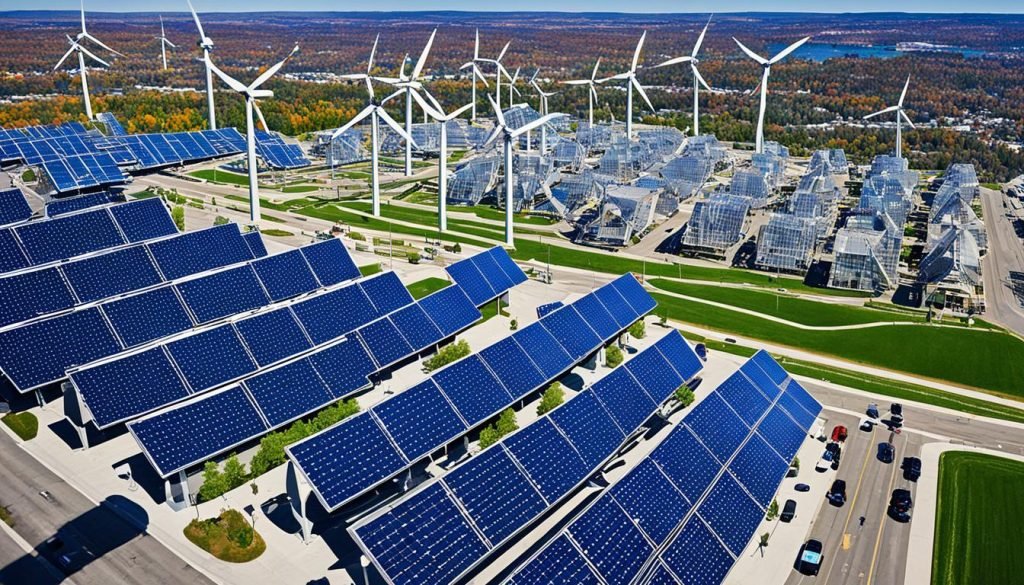
| Category | Benefits | Impact on Economy |
|---|---|---|
| Affordable Energy | Lower energy bills for consumers | Boosts household income |
| Job Creation | Diverse employment opportunities | Strengthens local workforce |
| Economic Growth | Investment in infrastructure | Increases regional competitiveness |
Types of Renewable Energy Sources
Exploring the different kinds of renewable energy shows how important they are for a green future. Each type has its own benefits and helps make energy production more diverse.
Solar Power: Efficient and Affordable
Solar power is easy to get and very useful. It turns sunlight into electricity with photovoltaic panels. Thanks to new tech, solar power is now cheaper and more efficient. People and businesses use it to save money and protect the planet.
Wind Energy: Harnessing the Power of Nature
Wind energy uses turbines to catch wind and make clean energy. Offshore wind farms are getting popular, adding a lot to the energy mix. Wind projects can grow big to meet different energy needs.
Hydroelectric Power: Reliable Energy Source
Hydroelectric power is very reliable and can grow big. It uses water flow to make electricity when it’s needed. Hydroelectric plants help balance out other energy sources, keeping the energy steady.
Geothermal Energy: Tapping into Earth’s Heat
Geothermal energy uses the Earth’s heat for power and heating. It’s not affected by the weather, making it a steady energy source. Geothermal plants are a green way to meet energy needs at home and in businesses.
Biofuels: Utilizing Organic Materials
Biofuels come from plants and help with waste and energy. They cut down on harmful gases and offer a green fuel for cars and heating. Making biofuels from plants and waste helps the planet and supports sustainable energy.
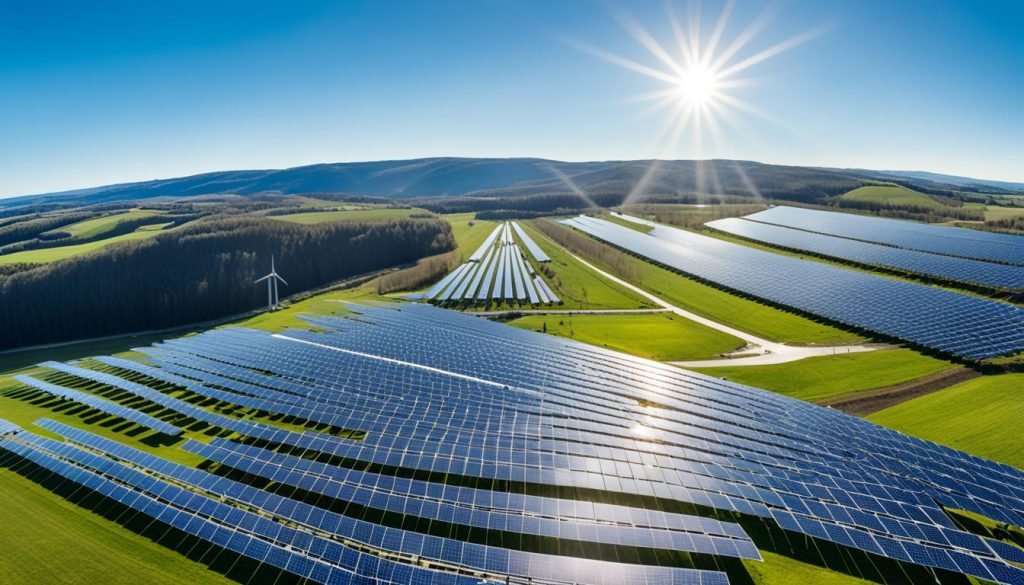
| Energy Source | Advantages | Applications |
|---|---|---|
| Solar Power | Cost-effective, widely accessible | Residential, commercial, utility-scale |
| Wind Energy | Scalable, clean, and renewable | Electricity generation, rural electrification |
| Hydroelectric Power | Reliable, adjustable output | Grid balancing, large-scale energy supply |
| Geothermal Energy | Constant energy availability | Heating, electricity generation |
| Biofuels | Utilizes waste materials | Transportation, heating |
Economic Benefits of Renewable Energy
Switching to renewable energy has big economic perks. It’s good for the planet and boosts the economy and stability.
Job Creation Potential in the Green Sector
Putting money into renewable energy means more jobs. Studies say the green sector could create millions of jobs soon. By 2030, it might offer up to 30 million jobs.
This job growth helps local economies and lifts communities. It means a better future for workers and their families.
The Cost-Effectiveness of Renewable Technologies
Renewable energy is getting cheaper as technology gets better. Solar and wind power are easier on the wallet. To switch to renewable energy by 2030, we’ll need about $4.5 trillion.
This money will save us a lot, cutting pollution costs by about $4.2 trillion a year. This shows how good clean energy is for the wallet.
Long-Term Investment Returns
Investing in renewable tech is a smart money move. It creates jobs and saves money right away. Plus, it ensures steady and clean energy for the future.
With the world needing more energy, these investments are a win-win. They make the economy strong and support sustainable living.
| Aspect | Job Creation | Cost-Effectiveness | Long-Term Investment |
|---|---|---|---|
| Estimated Jobs by 2030 | 30 million | Investment: $4.5 trillion annually | Annual Savings: $4.2 trillion |
| Sector Growth | Green Sector | Renewable Technologies | Stable Energy Future |
Challenges in the Transition to Renewable Energy
Switching to renewable energy is key for a sustainable future, but it faces hurdles. One big problem is the ups and downs in energy from sources like solar and wind. To fix this, we need better ways to store energy so power is always there when we need it.
Intermittency and Energy Storage Solutions
Storing energy is crucial to handle the unpredictable nature of renewable energy. Big energy storage systems help keep the power grid stable, even when energy generation goes down. We’re looking at technologies like lithium-ion batteries, pumped hydro storage, and new ideas to solve these issues. With enough storage, moving to a renewable energy grid will be smoother.
Investment and Infrastructure Needs
We need a lot of money to build the infrastructure for renewable energy. Governments and companies must work together to make this happen. They should support research and increase production of energy technologies. As we use more clean energy, we’ll have to keep improving our infrastructure to keep up with renewable energy growth.
| Challenge | Description | Impact on Transition |
|---|---|---|
| Intermittency | Fluctuations in energy supply from sources like solar and wind. | Requires advancements in energy storage to maintain a reliable power supply. |
| Energy Storage | Need for efficient systems to store generated energy for later use. | Stabilizes the grid and supports continuous energy provision. |
| Investment in Renewables | Funding needed for research, development, and implementation. | Drives innovation and enhances infrastructure capabilities. |
| Infrastructure Needs | Modernization of the existing grid to accommodate renewables. | Essential for integrating renewable sources into energy supply. |
Innovative Trends in Renewable Energy Technology
Renewable energy technology is changing fast, making sustainable energy solutions better. We aim to use less energy and get more from the sun, wind, and water. These changes show our commitment to using nature’s power wisely.
Energy Efficiency Practices
Using energy wisely is key to saving resources and cutting costs. It also helps reduce harmful emissions. Some top ways to do this include:
- Smart grids that manage energy better.
- Appliances that use less power.
- Building upgrades for better insulation and energy use.
- Systems for tracking energy use closely.
Emerging Technologies: Ocean Energy
Ocean energy is a new and exciting area. It’s all about using the power from waves and tides. The ocean is full of energy waiting to be used. Now, we’re working on:
- Creating devices to catch wave energy.
- Using underwater currents for energy.
- Building support for ocean energy projects.
- Testing ocean energy systems.
Working on these new trends shows our strong support for renewable tech. By focusing on using energy wisely and exploring ocean energy, we can create a future that’s good for the planet. This will help meet the energy needs of future generations.
Conclusion
Switching to renewable energy is essential for a sustainable future. Climate change and the need for more energy security make it crucial. Sources like solar, wind, hydroelectric, geothermal, and biofuels are key to cutting down on greenhouse gases and making us less dependent on others for energy.
Investing in renewable tech helps the environment and boosts the economy. It creates jobs and drives innovation. This shift to clean energy can lead to millions of new jobs, helping communities all over the U.S.
Even with challenges like the ups and downs of renewable energy and the need for better infrastructure, we can overcome them together. By focusing on sustainable energy, we can create a future that’s good for the planet and our economy. Let’s work together to make sure we leave a healthy planet for the next generations.

